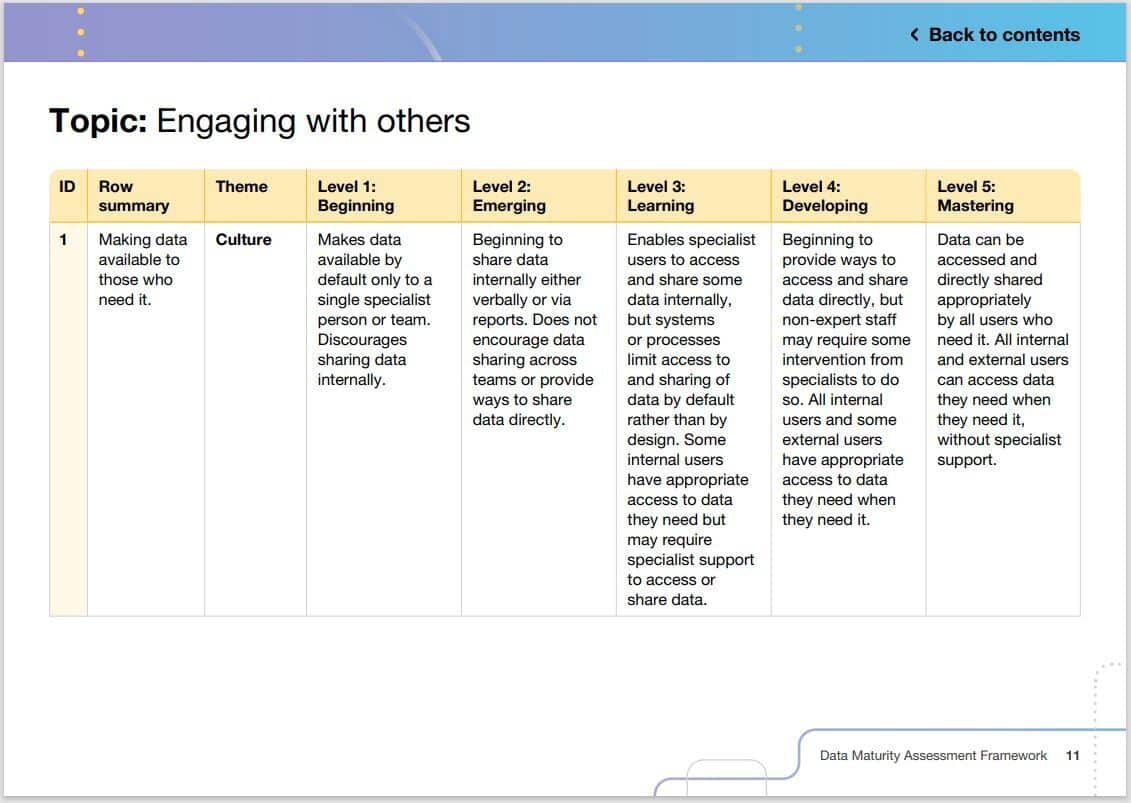Have you been instructed to deliver a Data Maturity Assessment for Government (DMAG) but don’t know where to start? This blog will help you get stuck in.
In launching the DMAG, Megan Lee Devlin, the CEO of Central Digital and Data Office (CDDO), said, “Permanent Secretaries, Chief Digital and Information Officers, and Chief Data Officers across government have endorsed this important tool and committed to using it in a core part of their organisation within the first year.”
The expectation from the Cabinet Office is for wide adoption across the public sector. However, the DMAG maturity framework is also freely available and potentially suitable for wider use.

What is the DMAG Framework?
The DMAG framework is comprehensive for a Data Maturity Assessment (DMA). This will build a picture of the data maturity across a department or organisation, but it takes some getting to grips with!
In summary, there are 97 assessment rows across 10 topics of data maturity. Each row is also aligned to a cross-cutting ‘theme’. Each row has a detailed description of what would score between a Level 1 (Beginning) and Level 5 (Mastering).

As this is a qualitative framework, each row must be assessed and judged, rather than calculated. Overall this builds a picture of data maturity across an organisation’s data ecosystem, rather than providing a single ‘score’. This step is often a pre-requisite to building a data strategy or refining a roadmap.
Does that sound like a lot? When you’re attempting a comprehensive assessment like the DMAG, it really pays to break things down and take them one at a time.
From our experience, these are the six key steps to delivering the DMAG;
1. Understand the Framework
Get to grips with the intricacies of the DMAG and you’ll be able to articulate the assessment to set yourself up for success.
2. Focus your assessment
Shape the assessment to match your organisation’s function and objectives.
3. Balance and target your assessment methods
Target how engagement should be made with specialist and non-specialist stakeholders.
4. Run the assessment
Conduct the assessment thoroughly. Validate results with a knowledgeable party within the organisation.
5. Communicate the results
Provide a clear ‘so what’ to accompany the results.
6. Define forthcoming activities and objectives
Communicate the agreed commitments that will be undertaken to drive improvements.
Understanding the Framework
If you are responsible for delivering the DMAG, it is important to take the time to understand it. Doing this ahead of delivery as this will set you up for success. Then you’ll be able to talk it through with the rest of your organisation, most of whom will not encounter maturity assessments in their day to day roles.
You’ll also understand which data practices assessed would be most interesting to view in detail from your organisation’s perspective, either from corporate priorities or operational challenges.
The Gov.Uk site (Data Maturity Assessment for Government – GOV.UK (www.gov.uk)) gives some great insights to explaining how this has been created and the intended cross-government use.
Focus your assessment
As per the guidance, there is no need to hit all 97 DMAG rows. At least 40 rows are required for a full assessment.
To narrow this down, we would advise that rows included should be those aligned to either;
- The department or organisation’s objectives, the sector or environment that you are working in.
- The assessment should be balanced to ensure that there is good coverage for each topic and theme to add robustness to the assessment.
So, if you’re working with particularly sensitive data, we would suggest you include most, if not all criteria from ‘Protecting your data’. In this example, you may wish to reduce the number of rows assessed from ‘Engaging with Others’.
Balance and target your assessment methods
The assessment should take into account specialist and non-specialist views. Surveys provide a great method for rapid assessment and canvasing opinion from a large group. Significant effort should be put in to reword a survey such that non data specialists can understand, whilst staying true to the DMAG.
Interviews and Workshops can also be included. Typically these will support the DMAG scoring. In addition, these provide further insight into user issues and needs for data across the organisation. Whilst this isn’t included in the assessment, it can be used when the results are published.
Understanding your department or organisation will inform how to deliver the assessment. For example, ensuring that workshops are a safe space for people to give their honest feedback.
Regarding the assessment, it makes sense to plan out which assessment method should be used for each row. Building in multiple assessment methods for rows is ideal, however this will increase the scope of your work!
There are certain rows which will suit different assessment methods. For example, with row number 62 ‘Acquiring existing data in the right way, it would not be expected that an end user of an analytics platform (a data consumer) would be aware of the status of the data pipelines required to provide the data from the source system.
In this scenario, a targeted interview with a data engineer would likely be more appropriate. For other rows, such as 1. ‘Making data available for those who need it’, it is important to have a range of responses in order to balance whether user needs are met.
Run the assessment
It is important to conduct the assessment row-by-row, record the evidence used and how the decision has been arrived at. Decisions should be made based on what is the typical and usual. Throughout the evidence gathering, the extremes can often be drawn out. If there is contention, the DMAG guidelines advise to default to the lowest maturity level.
The results should then be further validated. This avoids any potential bias in the assessment and gives certainty to your current maturity level.
Communicate the results
The results should be presented back to internal stakeholders. It will be important to reintroduce the DMAG at this stage, such that the audience understand how the results have been presented.
There is an important step which is to define the ‘so what?’ around the results. Ask yourself:
- Are the results fit for purpose for our organisation?
- Would improved results support us to deliver our objectives?
- Are there limitations faced by staff due to gaps in the data maturity?
- Are there opportunities to provide a better service with enhanced data capability?
When delivering the results, it’s imperative to give context, and additional information or quotes that have been collected provide valuable insight. This builds the rich picture of data maturity and ultimately what the case for change is as an organisation. If actions have been agreed as a result of the DMAG, these should be communicated alongside the results. If actions are yet to be agreed, commit to a timeframe to provide these. This supports engagement and takes stakeholders on the journey of improving the data maturity.
Define future activities and objectives
At the time of writing, the DMAG is still within its first year of release, and may be refined in years to come.
We would suggest building the majority of your objectives at Topic and Theme level, in case any future changes are made to individual rows.
If you want to achieve buy in for your recommendations, it’s vital to clarify the business benefit that would be gained through an improvement in data maturity. Often efficiencies of effort, avoidance of regulatory penalties or increased revenues are cited. There may be other cultural benefits, such as improving data literacy across the organisation, which are not as clearly tied to increased revenues or reduced cost, but these are still of great value to your organisation.
The next steps are to put your plans into action and conduct another assessment in another 12-18 months.
If you’re looking for help delivering a Data Maturity Assessment for Government (DMAG) then please drop us a line stuart.benzies@theoaklandgroup.co.uk

Stuart Benzies
Stuart Benzies is a Senior Data Consultant at The Oakland Group, where he leverages his expertise to empower organisations to unlock their data’s full potential to create a brighter future.
Stuart has worked with some of the largest organisations in the world, transforming how they leverage data to improve customer experience, drive efficiencies, and make better decisions.

